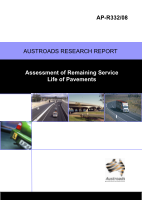Pavement

Assessment of Remaining Service Life of Pavements
- Publication no: AP-R332-08
- ISBN: 978-1-921329-92-0
- Published: 14 August 2008
- PDF (free) Download
This report documents the assessment of RSL of pavements where the RSL is confined in its estimation to the occurrence of the next major intervention either by rehabilitation or replacement. There are many measurable surface distress conditions, such as roughness, rutting, deflection and cracking, that can initiate major intervention. As also noted above, major intervention can be initiated by changes to the designated level of service required from the pavement which causes the current pavement to be sub-standard with respect to its revised designated level of service.
- Assessment of Remaining Service Life of Pavements
- Assessment of Remaining Service Life of Pavements
- Assessment of Remaining Service Life of Pavements
- Project Manager
- Austroads membership
- 1. introduction
- 1.1. Background
- 1.2. Aims and Context of this Report
- 2. RSL assessment process
- 2.1. Outline of Assessment Process
- 2.1.1. End of Effective Life (EEL)
- 2.1.2. Trigger Point (TP)
- 2.1.3. Remaining Service Life (RSL)
- 3. overview of the use of an rsl assessment
- 3.1. Main Uses of RSL
- 3.2. Estimating Current Asset Value
- 3.2.1. Estimation of Pavement Age
- 3.2.2. Estimating Pavement Replacement Cost
- 3.3. Reporting of Network Level KPIs
- 3.4. Estimating Programming and Budgets for Rehabilitation and Replacement
- 4. tools needed in assessing rsl
- 4.1. Predictive Tools
- 4.1.1. Deterioration Models
- 4.1.2. Works Effects Models
- 4.2. Data
- 4.2.1. Condition and Road Use Data
- 4.2.2. Pavement History Data
- 4.2.3. Inventory and Cost Data (only for asset valuation)
- 4.3. Other Information Needed in Assessing RSL
- 5. Summary
- 5.1. General
- 5.2. Summary
- references
- Appendix A Definition of key terms associated with remaining service life1F
- Appendix B examples of the assessment of rsl
- B.1 Examples of a Condition Based Assessment of RSL
- B.1.1 Rutting
- B.1.2 Roughness
- B.1.3 Deflection (strength)
- B.1.4 Final RSL assessment
- B.2 Examples of an RSL Assessment when the Current Designated Levels of Service become Inadequate
- B.2.1 Condition Based Assessment of RSL
- B.2.2 Function Based Assessment of RSL
- Appendix C examples of the uses of an rsl assessment
- C.1 Example of Estimating Current Asset Value
- C.1.1 Initial Asset Value
- C.1.2 Salvage Value
- C.1.3 Total Useful Life
- C.1.4 Current Asset Value
- C.2 Example of Reporting Network Level KPIs
- C.3 Example of Estimating Programming and Budgets for Rehabilitation, Restoration or Replacement
Related publications
Latest Pavement News
